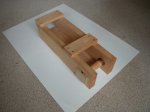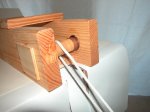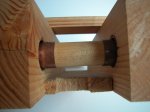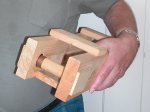www.cheops-pyramide.ch Copyright 2006 Franz Löhner and Teresa Zuberbühler
How were the pyramids built?
Franz Löhner's rope roll
 What exactly is a rope roll?
What exactly is a rope roll?
Why build separate ramps when the pyramid has four inclined planes as an integral part of its structure? Franz Löhner suggests a very simple device - a so called rope roll or reel station as the solution for how to build a pyramid without resorting to construction ramps. The rope roll is basically a small wooden stand made with planks and a movable beam with copper bearings over which a rope can be deflected and turned around.
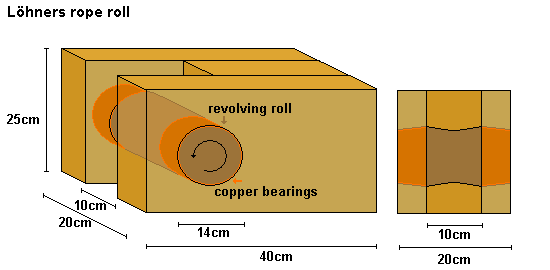
Illustration of a rope roll made from wood
The term "roll" only refers to the revolving roll. Löhner's rope roll is quite small, about 20cm wide, 25cm high and 40 cm long, and best made from cedar boards from the Lebanon, a specially resilient wood. The movable beam (roll) is round, has a diameter of about 14cm and is 20cm long. Only about 10cm of the beam are actually visible, but this is enough to put a rope around and deflect it. The movable cross beam was probably also made from cedar wood. The ends where it turns inside the holes made in the side wall of the wooden stand, are slightly tapered and covered with a copper sheet. These copper sleeve bearings are well lubricated, so the beam easily turns inside the holes.
![]() Comment:
Comment:
The rope roll shown here on the photos has obviously a roll with a smaller
diameter of only 5cm, but when tested it carried a stone of about a ton.
The rope roll originally used in 1991 by Franz Löhner to transport
a 5-tons-block (see report) had a larger diameter
of 14cm, but unfortunately we couldn't find it anymore today (2006).
|
Rope roll |
Detail of rope roll with rope |
Detail roll and copper bearings |
Detail roll and copper bearings |
Proportions |
The wooden stand which is the rope roll has to be anchored well
on the surface of the pyramid flank because the stones being
hauled up are very heavy and the slope quite steep. For this purpose a
specially cut outer Tura stone is used. This stone sticks out from the
otherwise plane outer surface of the pyramid and is bent slightly upwards.
The wooden block is put on top and fastened down with ropes or even with
a special wooden casing. On the causeway from the harbor to the foot of
the pyramid where the gradients are not so high, the rope rolls are only
anchored to the ground with poles.
![]() Illustration
of rope roll station and tracks on the pyramid flank
Illustration
of rope roll station and tracks on the pyramid flank
![]() Transporting the stone blocks using a
sledge on tracks (more information how the rope rolls were anchored)
Transporting the stone blocks using a
sledge on tracks (more information how the rope rolls were anchored)
These rope rolls have to be made in good quality but in large quantities (like the sledges). They were easy to swap, a worker could bring a replacement rope roll, just grab the old one and carry it under his arm down to the carpenter's workshop to overhaul or fix it.
 Is this a pulley or a block?
Is this a pulley or a block?
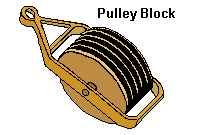 We
don't use the term "pulley" since a pulley
consists of several moving parts, so called sheaves which are all mounted
on a single axle, almost like a wheel with a grooved rim. Wheels and axles
were not known at the time when the Great pyramids were built. For a 2.5
tons stone a pulley made from wood doesn't work - the axle, if made from
wood, can easily break.
We
don't use the term "pulley" since a pulley
consists of several moving parts, so called sheaves which are all mounted
on a single axle, almost like a wheel with a grooved rim. Wheels and axles
were not known at the time when the Great pyramids were built. For a 2.5
tons stone a pulley made from wood doesn't work - the axle, if made from
wood, can easily break.
Unlike the pulley, Löhner's rope roll consists of a non movable wooden stand made with planks and a thick movable beam which can not be detached. Because the wooden beam is thick and well anchored inside the wooden block, the danger of breaking is much less, not like with the wooden axle of a wagon or a pulley.
On sailing ships, a set of these pulleys, a so called block is used. A system of two or more pulleys with a rope or cable threaded between them are assembled and form a tackle. The old Egyptians definitely didn't know this system which is used to lift or pull heavy loads, we don't find anything like a pulley on their paintings of ship riggings.
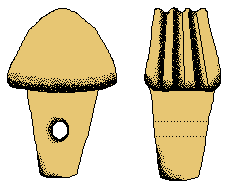 Two
stone implements, so called bearing stones, found at Giza, that were part
of an unknown device to pull or lower three parallel running ropes over
an edge. Archaeologists think, that it was put into an oblique shaft or
crane and used to lift or lower heavy weights - for example, a pillar
or a colossal statue [1].
Two
stone implements, so called bearing stones, found at Giza, that were part
of an unknown device to pull or lower three parallel running ropes over
an edge. Archaeologists think, that it was put into an oblique shaft or
crane and used to lift or lower heavy weights - for example, a pillar
or a colossal statue [1].
Franz Löhner, unlike some Egyptologists, doesn't think,
that it could have been used in such a way. This shape of stone is not
suited for a permanent heavy load. Neither stone nor the ropes could tolerate
that kind of strain for long.
![]() Ramp models described in details
(details about other proposed machines)
Ramp models described in details
(details about other proposed machines)
 Rope roll stations: array of the rope rolls
Rope roll stations: array of the rope rolls
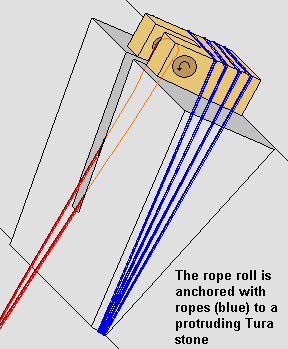 Franz
Löhner proposes, that sledges on tracks were used for transporting
the pyramid stones. One route with tracks came from the harbor to the
foot of the pyramid (= 4° average inclination with some stretches
of 8° to 24°) and then directly up the flank of the pyramid (=52°).
Without a rope roll you already need 53 haulers, if the inclination is
5°. With the same number of haulers, but deploying the rope roll,
you can easily pull the stone up the 52° angled pyramid flank. In
other words - only thanks to the rope roll these kind of gradients are
even possible to overcome.
Franz
Löhner proposes, that sledges on tracks were used for transporting
the pyramid stones. One route with tracks came from the harbor to the
foot of the pyramid (= 4° average inclination with some stretches
of 8° to 24°) and then directly up the flank of the pyramid (=52°).
Without a rope roll you already need 53 haulers, if the inclination is
5°. With the same number of haulers, but deploying the rope roll,
you can easily pull the stone up the 52° angled pyramid flank. In
other words - only thanks to the rope roll these kind of gradients are
even possible to overcome.
![]() Calculating the force and kinetic coefficient
of friction necessary (how many haulers)
Calculating the force and kinetic coefficient
of friction necessary (how many haulers)
![]() The pyramid building yard - the
center of the construction project (gradients)
The pyramid building yard - the
center of the construction project (gradients)
A wooden track is constructed directly on the pyramid face
and anchored on the casing. Two rope rolls are installed on both sides
of the track and well anchored, so the traction force of the stone cannot
rip or wrench them out and down. For this purpose special protruding casing
stones are used. The two rope rolls constitute a rope roll station.
A rope roll station is installed every 30-37m height and an additional
one on the edge of the pyramid plateau. On both sides of the track, a
ladder-like rig is installed. The stone block (weighting an average of
2.5 tons) is laid on a wooden sledge and tied down with ropes. The sledge
is then installed on the tracks. Of course the tracks and the skids of
the sledge are well lubricated with watered oil.
![]() Illustration
of rope roll station and tracks on the pyramid flank
Illustration
of rope roll station and tracks on the pyramid flank
The rope is routed around the beam of the rope roll, one
side is attached to the sledge with the stone, at the other end the haulers
pull. Two haulers together grab a crossbar handle (wooden toggle) attached
to the rope and, holding it in front of their chest, they push. When they
walk down, the sledge with the stone is carried up the tracks.
![]() Transporting the stone blocks using a
sledge on tracks (details hauling gear)
Transporting the stone blocks using a
sledge on tracks (details hauling gear)
![]() Transport up the pyramid flank with
Löhner's rope roll (details track system)
Transport up the pyramid flank with
Löhner's rope roll (details track system)
![]() Transporting the large granite blocks
up the pyramid
Transporting the large granite blocks
up the pyramid
 Lubrication
Lubrication
Oil or grease acts as a cushion between the wooden housing
and the bearing lying around the rotating beam. Oil is better than animal
grease for lubricating. Possibly copper grease was used
as a lubricant for the rope roll. Copper grease is easily produced - copper
is grinded as fine as possible, to get a better lubricating effect. The
copper abrasion is mixed with oil and becomes copper grease. The ancient
Egyptians knew both components - copper abrasion is produced, every time
you polish or burnish copper. Copper grease keeps its lubricating effect,
even if you heat it, that is why it is still used nowadays for car brakes.
![]() Calculating the force and kinetic coefficient
of friction necessary
Calculating the force and kinetic coefficient
of friction necessary
 How much strain / pressure / friction can a rope roll bear?
How much strain / pressure / friction can a rope roll bear?
Diameter of the roll:
The movable beam should be as short as possible, and - although
that causes more friction - should also have a large diameter. Thin beams
tend to bend, which causes additional friction, and they crack and break
much faster. Franz Löhner has done some practical tests and a 14cm
diameter is enough, because the beam is also quite short, only about 10cm
of it is exposed to high friction. But although the rope roll is lubricated
well, there is of course a certain abrasion at the interface between the
rope and the movable beam, so the beam has to be replaced often.
The bearing:
The copper sleeve bearing is deformed by the pressure (little attrition)
and has to be replaced often.
Burden / pressure:
Since the rope roll has to bear very heavy loads, the pressure per square
centimeter should not rise to high, because otherwise the roll will turn
sluggishly and then becomes inoperable.
![]() Transporting the large granite blocks
up the pyramid
Transporting the large granite blocks
up the pyramid
Lateral drag:
Because the rope rolls are installed in pairs to the left and right of
the tracks, the drag of the two ropes towards the middle is asymmetrical.
This means, that possibly the rope could jam between the movable beam
and the side wall. This is no problem, if the beam is shaped like a spool
with a rim (like a bobbin) or if the rope roll is placed in a slight angle
on the Tura stone and anchored.
Ropes:
Because the roll inside the rope roll turns together with the rope, not
that much friction is caused. Ropes made from hemp should not be kinked
too often, so they have to revolve around a roll with a minimum diameter.
If the diameter of the roll (or beam) is too small, the ropes will break
more often. The friction of the rope will also groove the wooden beam
after some time, so the rope roll has to be replaced.
![]() Transporting the stone blocks using a
sledge on tracks
Transporting the stone blocks using a
sledge on tracks
 Which principle is behind the rope roll?
Which principle is behind the rope roll?
Which principle is behind this? Only because
the haulers can add their own weight to their strength to pull the stone
up, it is possible to haul the 2.5 tons stone up the 52°-slope on
the pyramid flank. Without the rope roll to turn the rope around, it would
not be possible. Calculations show, that without the rope roll even on
a moderate slope of only 5°, you already need over 50 men to pull
the same 2.5 tons stone block up.
![]() Calculating the force and kinetic coefficient
of friction necessary
Calculating the force and kinetic coefficient
of friction necessary
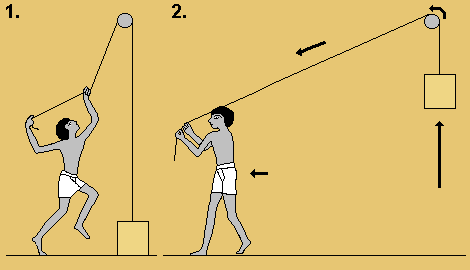
Egyptian lifts a stone block up by flinging a rope over a beam. Then he walks away while pulling the rope.
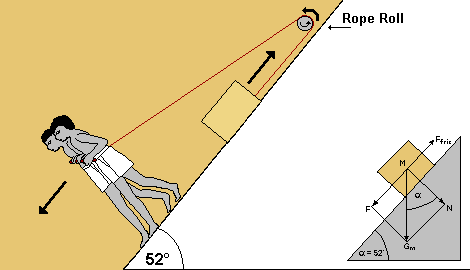
The illustration above shows the same principle but on
an inclined plane and with a movable beam (= rope roll). We use an angle
of inclination of 52° which is the inclination of the lateral surface
of Khufu's pyramid. Two haulers are walking down (on a ladder-like rig)
and pull the stone up. The steeper the incline, the better the haulers
use their own weight as a load to counterbalance the stone being carried
up.
![]() Transport up the pyramid flank with
Löhner's rope roll
Transport up the pyramid flank with
Löhner's rope roll
![]() Calculating the force and kinetic coefficient
of friction necessary
Calculating the force and kinetic coefficient
of friction necessary
Very simple techniques, that the ancient Egyptians surely could manage are used to manufacture and employ the rope rolls! The same principle was used in the antechamber of the King's chamber in the pyramid of Khufu to suspend and the lower granite portcullis slabs (see historical sources further down).
 Where can Franz Löhner's rope roll be used?
Where can Franz Löhner's rope roll be used?
Our calculations show, that rope
rolls had to be used where the angle of inclination was more than 5 degrees.
Over and above this inclination, the haulers need much less force with
than without the rope roll. With the help of the rope
roll there is no need to build huge construction ramps, since you can
transport the stones much more effectively. The 52° inclination
of the pyramid flank is no problem whatsoever!
![]() The pyramid building yard - the center
of the construction project
The pyramid building yard - the center
of the construction project
![]() Theories of pyramid ramp systems disproved
Theories of pyramid ramp systems disproved
| 1. | New | On all tracks (harbor to building yard, quarries to building yard etc.) Löhner's rope rolls are used, if the angle of inclination is more than 5° (doctrine = hauling teams pull sledges up ramps) |
| 2. | New | For the construction of the pyramid at least five tracks are built directly on the pyramid flank. By using Löhner's rope rolls the stones on sledges are hauled directly up the pyramid (doctrine = huge transport ramps are built and lead up to the pyramid. Most Egyptologists propose either winding or straight ramps) |
| 3. | New | The large granite blocks are brought up to the chosen height with a specially constructed heavy duty track with several rope rolls (doctrine = the granite blocks were pulled up on large construction ramps or they were stored on the growing pyramid plateau and levered up each time a new stone layer was added) |
| 4. | New | The pyramidion was hauled up on four successive rope roll stations directly on the pyramid flank up to the top (doctrine = the pyramidion was pulled up on large construction ramps or it was stored on the growing pyramid plateau and levered up each time a new layer was added - 210 layers!) |
![]() Transporting the stone blocks using a
sledge on tracks
Transporting the stone blocks using a
sledge on tracks
![]() Transport up the pyramid flank with
Löhner's rope roll
Transport up the pyramid flank with
Löhner's rope roll
![]() Transporting the large granite blocks
up the pyramid
Transporting the large granite blocks
up the pyramid
![]() Transporting the pyramidion to the top of
the pyramid
Transporting the pyramidion to the top of
the pyramid
 Five requirements that every pyramid construction theory should fulfill
Five requirements that every pyramid construction theory should fulfill
Franz Löhner stipulates that any method or theory for pyramid construction should fulfill the following 5 requirements, otherwise it should be rejected:
1. A solution that is as simple as possible using a technology that is
as simple as possible (Occam's razor)
2. Continuity in technical matters and craftsmanship
3. Verification through pictures and/or text
4. Technology keeping with the time and culture
5. The supposed technique / method must really be a solution
 A simple solution / method?
A simple solution / method?
Does the solution proposed on this page by Franz Löhner also meet those five requirements?
| About the 1st requirement (simple solution):
Franz Löhner's methods don't ask for time-consuming or complicated techniques, but what he proposes are by all means techniques, that the ancient Egyptians knew and had mastered! |
What is simpler than to sling a rope over a wooden roll and pull? Of course you first need the idea and inspiration, to do it in such a way, but for solving the technical details you can use simple methods.
Actually you should say - why hasn't anybody else thought about this - why hasn't anybody else hit on this solution before! But we think, somebody had this inspiration before - namely the ancient Egyptians!
An important fact is, that with the help of this method
you need much less workers and much less time to finish building the pyramid.
Our detailed calculations show, that already with a slight inclination
of 5° it is worth while to use rope rolls and inclinations of more
than 10° can probably not be managed without the help of the rope
rolls.
![]() Calculating the force and kinetic coefficient
of friction necessary
Calculating the force and kinetic coefficient
of friction necessary
 What was found? The historical sources
What was found? The historical sources
|
About the 2nd requirement (technical
continuity): |
Actually you can state, that as soon as humans invented ropes they must have noticed, that if you throw them over a tree branch, you can pull small loads up and secure them there out of reach of hungry animals. But to prove, that the Egyptians knew what kind of principle the rope rolls uses we would like to mention the bow drill. This kind of drill can be used for drilling holes or for making fire. The bow drill is an ancient tool, which consists of a bow with the bowstring wrapped around a stick (= principle of the rope roll). The stick is held in place, and the bow is pulled back and forth in a fiddling movement, which makes the stick spin.
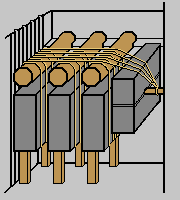 The
same principle was used in the antechamber of the king's chamber in Khufu's
pyramid to suspend and lower the granite portcullis slabs. These slabs
blocked the corridors and were meant to impede any grave robbers who wanted
to break into the burial chamber. This system didn't help much - the robbers
probably climbed over the lowered portcullises and chiseled off enough
of the granite over the entrance to the burial chamber to be able to enter.
The
same principle was used in the antechamber of the king's chamber in Khufu's
pyramid to suspend and lower the granite portcullis slabs. These slabs
blocked the corridors and were meant to impede any grave robbers who wanted
to break into the burial chamber. This system didn't help much - the robbers
probably climbed over the lowered portcullises and chiseled off enough
of the granite over the entrance to the burial chamber to be able to enter.
The manner how those heavy portcullis slabs were suspended uses the same principle as the rope roll. Ropes were slung over a round longitudinal support (= roll) and then tied to a cross beam. The rope glided over the beams and the huge weights moved, but there was no wheel or axle involved. The slabs were probably held in position by wooden supports [1]. The same principle was used to lower other portcullises and stone plugs into corridors and shafts - putlog holes for the wooden beams were found in several tombs. The Egyptologist D. Arnold also writes: "The revolving beams inserted into the side walls of the portcullis chamber of the Cheops Pyramid suggest, however, that the engineers of the Forth Dynasty already had some basic knowledge of changing the direction of pull and reducing the tractive force." [1 page 71]
The round cross beams were resting on specially shaped stones, which had a semicircular cut on top. Franz Löhner thinks, that the tracks he suggests for the sledges were also anchored to the pyramid flank on similar looking Tura stones (see illustration)

We also know, that the ancient Egyptians used stringed instrument such as harps, with pegs for tuning the cords. The pegs were rotated inside holes to coil the cord up. This is the same principle used with a rope roll.
| About the 3d requirement (verification
through pictures and/or text): There are no illustrations showing the construction of the pyramids. No pictures of a rope roll has been found. |
That doesn't surprise, since the rope roll is such a mundane and simple apparatus. Maybe - but those are speculations - there is an illustration of a rope roll, but its significance hasn't been recognized.
| About the 4th requirement (technology
keeping with the time and culture): Since the rope roll is easily fabricated, using technology keeping with the time and culture - you only need wood and copper sheets - this requirement is met with no problems. |
On the other side all kinds of hoist and lifting devices have been suggested
in the place of ramps, very often either using techniques or materials
that the Egyptians didn't yet know at the time of the construction of
the pyramids.
![]() Using machines for the construction
of the pyramid
Using machines for the construction
of the pyramid
 Questioning this technique / method
Questioning this technique / method
|
About the 5th requirement (is this
technique / method really a solution?): |
Question:
Have you built and tried out a rope roll?
F. Löhner's answer:
1991 I used a pair of rope rolls to haul a 5 tons stone in a quarry in
Germany. That is to say I first built a sledge made with round timber
and interlocked with two cross pieces and then tracks made from logs.
Two rope rolls made from wood and with copper bearings were installed
on top of an incline of a bit more than 45°. The rolls had a diameter
of 14cm and a length of 22cm (only 5cm left for the rope). The bearings
of the roll were well lubricated, I assume, the Egyptians also did it
like that. However I didn't have enough humans at my disposal for hauling,
but I had a measuring device. We used a forklift and installed the measuring
device in front of it. Everything worked without problems, the stone was
pulled up the incline, the rope roll didn't break and the rope didn't
tear.
![]()
Question:
Why is the actual roll (or cross beam) made from wood and not metal, for
example copper?
F. Löhner's answer:
Untempered copper deforms if strained. If a roll made with copper deforms
there is a large risk of accidents, the whole rope roll could brake apart,
specially the wooden parts.
![]()
Question:
There is an Egyptian frieze where the colossal statue of Djehutiotep is
pulled on a sledge. It shows hauler, that are walking in front
of the statue and in the same direction.
F. Löhner's answer:
This sacral act was a one-time transport. Probably with a lot of spectators
and religious ceremonies. I think, already the barge-like sledge shows
the religious signification, it reminds of the solar barge of Ra (Rê).
So it was done slower and on moveable tracks. If you have to haul thousands
of stones, it is much more important to do it efficiently - using the
rope roll!
![]()
 Sources
Sources
These methods for building the pyramids were first published 1993 in the book "Der Bau der Cheops-Pyramide" by Heribert Illig and Franz Löhner.
[1] D. Arnold Building in Egypt
www.cheops-pyramide.ch Copyright 2006 Franz Löhner and Teresa Zuberbühler
